Machiya
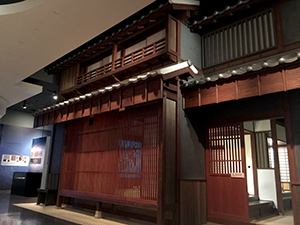
The Machiya corner reconstructs a merchant house that stood in Nagasaki in the Edo period. Here, traditional decorations and dishes are recreated and displayed in accordance with seasonal events such as Tanabata, Obon, the Kunchi festival, and New Year’s. A series of pictures depicting annual events by Nagasaki artist Kawahara Keiga serve as reference.
Location: 2F Permanent Exhibition Gallery, inside the Historical and Cultural Zone
(Life in Nagasaki corner)
Admission: included in the Permanent Exhibition admission fee
(adults 630 yen, elementary, junior high and high school students 310 yen)
Opening times: as per the Museum’s opening hours
April to November: 8:30-19:00, last entry 18:30
December to March: 8:30-18:00, last entry 17:30
Machiya Calendar
Hinamatsuri
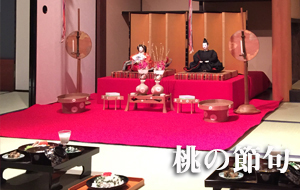
On Hinamatsuri, it is the custom to display a set of ornamental dolls, called “Hina dolls”, and pray for the health and happiness of young girls. In Nagasaki, families celebrating a child’s first Hinamatsuri used to display the dolls received from relatives and hold a party to thank them. Girls would receive hair ornaments and sweets, and even boys were given small flags and other little gifts.
Dates: February 18 (Tue) – April 20 (Sun), 2025
Boys’ Day
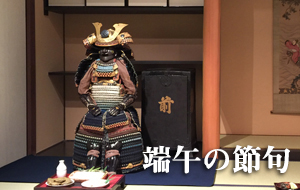
On May 1st, in Nagasaki, in the households where a boy had been born the previous year, the baby’s first festival was celebrated by setting up a new nobori. These are windsocks made of cotton or cloth, and attached to a pair of stands. Family crests, cranes and tortoises, pine, bamboo and plums, and the god Shoki were printed on the fabric, and ornaments such as monkeys and little bells were hung from them. In addition, miniatures of battle standards, spears and swords were displayed. On May 5th, at the Nagasaki Magistrate’s Office city officials were served red bean rice and simmered vegetables. Meanwhile, Nagasaki merchants would visit Suwa Shrine early in the morning, and then go around visiting their acquaintances to exchange greetings.
Dates: April 22 (Tue) – June 15 (Sun), 2025
Tanabata
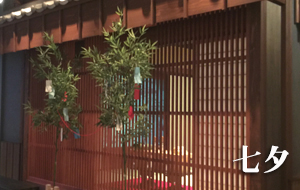
Tanabata is the Star Festival held on July 7th. The festival was celebrated in every household writing poetry and wishes on five-colored (blue, red, yellow, white and black) strips of paper and hanging them on bamboo branches. In the Muromachi period (1336-1573), various amusements connected with the number seven were also organized, such as the reading of seven hundred poems, the performance of seven tone music and the offering of seven drinks.
Dates: June 17 (Tue) – July 21 (Mon), 2025
Obon
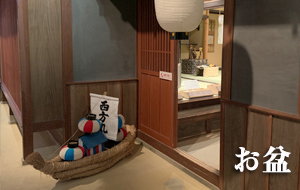
Obon is primarily an event to worship one’s ancestors and the souls of deceased relatives, and to pray for their repose. However, in Nagasaki it was handed down as an occasion to welcome and then send back the spirits that, once a year, return from the Pure Land, as if they were living beings.
Dates: July 23 (Wed) – August 17 (Sun), 2025
Mid-Autumn Festival
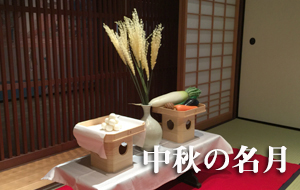
The Mid-Autumn Festival was celebrated on the 15th day of the 8th lunar month of the traditional Japanese calendar, and today falls around September 15th. This night’s moon is called “the harvest moon”. When the Mid-Autumn Festival and the custom of moon-viewing (tsukimi) were introduced from China, the Japanese started the tradition to set up an altar to offer that year’s crops, watch the clear moon shining in the autumnal night sky, and pray for the next year’s harvest.
Dates: August 19 (Tue) – September 15 (Mon), 2025
Kunchi Festival
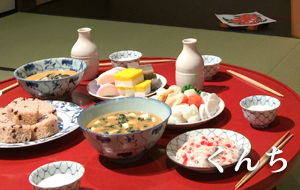
The Nagasaki Kunchi is the great autumn festival of Suwa Shrine. Its dedicatory dances embody Nagasaki’s unique culture and performing arts, and have been designated as Important Intangible Folk Cultural Properties of Japan.
Households beloging to the Odori-chō (the city districts in charge of that year’s dedicatory dances) and to the Tori-chō (other districts located on the route of the festival parade) are very busy during the festival: for this reason, Kunchi food is served on large plates, from which everyone can help themselves, as well as serve to guests. The name and shape of the sweets and fruits served are associated with auspicious images.
Dates: September 17 (Wed) – October 19 (Sun), 2025
Tōji
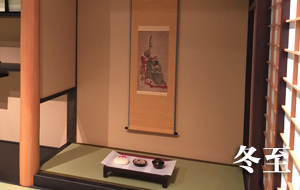
Tōji, or winter solstice, is one of the 24 solar terms in which the year is divided according to the traditional Chinese calendar. In the modern calendar, it falls around December 22nd, and is the shortest day of the year in the Northern hemisphere, when the sun’s maximum elevation in the sky is at its lowest.
In the Chinese Quarter of Nagasaki, a banquet would be held on this day. It was a grand party, where not only alcohol, but also tōjin-dango (sweet dumplings) and zenzai-mochi (sweet red bean soup with mochi) were served. The custom spread through the city, and Nagasaki’s merchant families took to decorate their houses’ tokonoma (alcoves) with scrolls depicting the Chinese god Guan Yu, and to make offerings of zenzai-mochi.
Date: October 21 (Tue) – December 25 (Thu), 2025
New Year
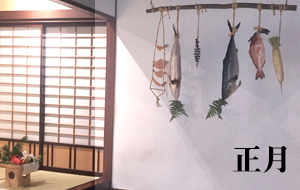
Seasonal decorations are prepared before the end of the year to be ready for the New Year’s celebrations. Since the Edo period (1603-1868), people in Nagasaki would build a special shelf called ehōdana and put up kadomatsu (pine branches) and shimenawa (sacred straw rope) decorations from December 28th.
Nagasaki’s characteristic New Year’s foods are zōni (a soup containing boiled vegetables, fish, chicken and mochi) and nanbanzuke (marinated fried fish). Although today New Year’s foods, called osechi, are packed in tiered lacquer boxes, originally they were served on a four-legged tray, or ozen. A formal banquet would begin with spiced sake and go on with a first and second course.
Dates: December 26 (Fri) – January 18 (Sun), 2025
Setsubun
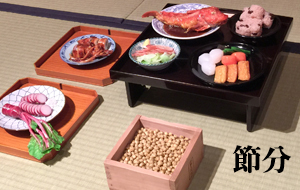
In the traditional Japanese lunar calendar, Setsubun referred to the the day just before the first day of spring, called Risshun. During the Heian period (794-1185), a purification ceremony to ward off plagues and other calamities was enacted at the Imperial palace on this day. The ritual was initially observed on the last day of the year, but later came to be performed on the night of Setsubun.
Dates: January 20 (Tue) – February 18 (Sun), 2026
*From February 17 (Tue), 2026 Hinamatsuri display.

